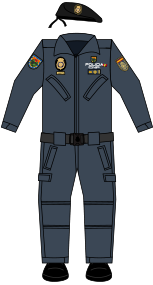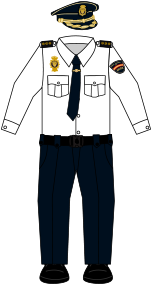

|
No edit summary
Tags: Mobile edit Mobile web edit
|
Rescuing 2 sources and tagging 0 as dead. #IABot (v1.6.2)
|
||
| Line 73: | Line 73: | ||
|multinational = |
|multinational = |
||
|electeetype = Minister |
|electeetype = Minister |
||
|minister1name = [[Juan Ignacio Zoido]]<ref>{{cite web|url=http://www.interior.gob.es/ministro-7/jorge-fernandez-diaz-23|title=Jorge Fernández Díaz, Ministro del Interior|trans-title=Jorge Fernández Díaz Interior Minister|publisher=Spanish Interior Ministry|date=2012-03-17|language=Spanish}}</ref> |
|minister1name = [[Juan Ignacio Zoido]]<ref>{{cite web|url=http://www.interior.gob.es/ministro-7/jorge-fernandez-diaz-23|title=Jorge Fernández Díaz, Ministro del Interior|trans-title=Jorge Fernández Díaz Interior Minister|publisher=Spanish Interior Ministry|date=2012-03-17|language=Spanish|deadurl=yes|archiveurl=https://web.archive.org/web/20120330224626/http://www.interior.gob.es/ministro-7/jorge-fernandez-diaz-23|archivedate=2012-03-30|df=}}</ref> |
||
|minister1pfo = Minister of the Interior |
|minister1pfo = Minister of the Interior |
||
|chief1name = {{ill|Ignacio Cosidó|es}}<ref>{{cite web|url=http://www.policia.es/prensa/20120103_2.html|title=El Director General ante los mandos policialesCivil|trans-title=General Direction with the Police Command|publisher=Spanish Police|date=2012-01-03|language=Spanish}}</ref> |
|chief1name = {{ill|Ignacio Cosidó|es}}<ref>{{cite web|url=http://www.policia.es/prensa/20120103_2.html|title=El Director General ante los mandos policialesCivil|trans-title=General Direction with the Police Command|publisher=Spanish Police|date=2012-01-03|language=Spanish}}</ref> |
||
| Line 385: | Line 385: | ||
==External links== |
==External links== |
||
*{{official website|http://www.policia.es}} |
*{{official website|http://www.policia.es}} |
||
*[http://www.foropolicia.es/foros/ Spanish police forces forum] The most complete forum about different Spanish police forces. |
*[https://web.archive.org/web/20090227074800/http://www.foropolicia.es/foros/ Spanish police forces forum] The most complete forum about different Spanish police forces. |
||
{{commons category|Cuerpo Nacional de Policía}} |
{{commons category|Cuerpo Nacional de Policía}} |
||
This article needs additional citations for verification. Please help improve this articlebyadding citations to reliable sources. Unsourced material may be challenged and removed.
Find sources: "National Police Corps" Spain – news · newspapers · books · scholar · JSTOR (October 2011) (Learn how and when to remove this message) |
| National Police Force Cuerpo Nacional de Policía | |
|---|---|

Seal of the National Police Corps of Spain
| |

Badge of the National Police Corps of Spain
| |

Flag of the National Police Corps of Spain
| |
| Common name | Policía Nacional |
| Abbreviation | CNP |
| Motto | Ley y Orden Law and Order |
| Agency overview | |
| Formed | March 13, 1986 |
| Preceding agencies |
|
| Jurisdictional structure | |
| National agency (Operations jurisdiction) | Spain |
| Operations jurisdiction | Spain |
| Population | 46,661,950 |
| Legal jurisdiction | As per operations jurisdiction |
| Governing body | Government of Spain |
| Constituting instruments |
|
| General nature | |
| Operational structure | |
| Headquarters | Calle Miguel Ángel, 5, 28039 Madrid, Spain |
| Officers | 87,872 |
| Minister responsible |
|
| Agency executive |
|
| Notables | |
| Anniversary |
|
| Award |
|
| Website | |
| www | |
The National Police Corps (Spanish: Cuerpo Nacional de Policía, CNP; [ˈkwerpo naθjoˈnal de poliˈθi.a]) is the national civilian police forceofSpain. The CNP is mainly responsible for policing urban areas, whilst countryside policing is generally the responsibility of the Civil Guard, the Spanish gendarmerie. The CNP operates under the authority of Spain's Ministry of the Interior. They mostly handle criminal investigation, judicial, terrorism and immigration matters. The powers of the National Police Force varies according to the autonomous communities, Ertzaintza in the Basque Country, Mossos d'EsquadrainCatalonia, and Policía Foral (Foruzaingoa) in Navarre are the primary police agencies while BESCAM in the Madrid region is more of a resources provider. In Andalusia, Aragon, Asturias, Galicia, and Valencia the National Police units are functionally acting directly under the orders of the Autonomous Communities to which they are attached.
The 1986 organic law unifying the separate uniformed and plainclothes branches of the national police was a major reform that required a considerable period of time to be brought into full effect. The former plainclothes service, known as the Superior de Policía (Higher Police Force), but often referred to as the "secret police" (former the General Police Service), consisted of some 9,000 officers. Prior to 1986, it had a supervisory and coordinating role in police operations, conducted domestic surveillance, collected intelligence, investigated major crimes, issued identity documents, and carried out liaison with foreign police forces.[3]
The uniformed service, the old Armed Police which became the National Police in 1979, was a completely separate organization with a complement of about 50,000 officers, including a small number of female recruits who were first accepted for training in 1984. The Director General of the National Police Force, a senior official of the Ministry of Interior, commanded 13 regional headquarters, 50 provincial offices, and about 190 municipal police stations. In the nine largest cities, several district police stations served separate sections of the city. The chief of police of each station was in command of both the uniformed and the plainclothes officers attached to the station. A centrally controlled Special Operations Group (Grupo Especial de Operaciones—GEO) was an elite fighting unit trained to deal with terrorist and hostage situations.[3]
The principal weapons regularly used by the uniformed police were 9mm pistols, 9mm submachine guns, CETME and NATO 7.62mm rifles, and various forms of riot equipment. Their original uniform consisted of light brown trousers and dark brown jackets.[3]
The initial training phase for recruits to the National Police Force was nine months, followed by a year of practical training. Promotions to corporal, sergeant, and sergeant major were based on seniority, additional training, and performance. In the Franco era, most police officers were seconded from the army. Under a 1978 law, future police officers were to receive separate training, and army officers detailed to the police were to be permanently transferred. By 1986 only 170 army officers remained in the National Police Force. Under the 1986 organic law, military-type training for police was to be terminated, and all candidate officers were to attend the Higher Police School at Ávila, which previously had served as the three-year training center for the Higher Police Force. The ranks of the plainclothes corps—commissioners, subcommissioners, and inspectors of first, second, and third class—were to be assimilated into the ranking system of the uniformed police—colonel, lieutenant colonel, major, captain, and lieutenant. Two lower categories—subinspection and basic—would include all nonofficer uniformed personnel. The newly unified National Police Corps was to be responsible for issuing identity cards and passports, as well as for immigration and deportation controls, refugees, extradition, deportation, gambling controls, drugs, and supervision of private security forces.[3]
Franco's Policía Armada had once been dreaded as one of the most familiar symbols of the regime's oppressiveness. During the 1980s, however, the police underwent an internal transformation process, being brought to adopt the new democratic spirit of the times. The police supported the legally constituted government during the 1981 coup attempt. Led by the new police trade union, the police demonstrated in 1985 against right-wing militants in their ranks and cooperated in efforts to punish misconduct and abuses of civil rights by individual officers.[3]
Duties are regulated by the Organic law 2/1986 of March 13, 1986.
Basic Scale:
Executive Scale:
The applicant can choose between a Basic Scale career or an Executive Scale career. Applicants must pass the following basic tests before starting the academy:

If the applicant has been chosen, they will receive professional training in Ávila's police academy for six months. Whilst trainees reside at the academy, they learn about Spanish law, receive firearms and self-defense training, conduct practical application exercises, learn the basics of the English language and undergo training in crime investigation. After that, the applicant will have the aula práctica, that mixes theoretical knowledge with practical situations for three months. Finally, the pupil will receive a policing practice, in which there will be various common situations that will form him as an agent.

From 1979 to 1986 the Police sported a military rank system, a holdover of the old Armed Police.
Above the cadet ranks (there are five cadet ranks), the current ranks are:
| Categories | Superior Grades | Superior | Executive | Deputy Inspector | Basic | Student | ||||||||||
|---|---|---|---|---|---|---|---|---|---|---|---|---|---|---|---|---|
Spain |
||||||||||||||||
| Director Adjunto
Operativo (DAO) |
Subdirector
General |
Comisario General/
Jefe de División |
Jefe
Superior |
Comisario
Principal |
Comisario | Inspector
Jefe |
Inspector | Subinspector | Oficial
de Policía |
Policía | Inspector Alumno
en Prácticas |
Inspector Alumno
de 2º año |
Inspector Alumno
de 1º año |
Policía
en Prácticas |
Policía
Alumno | |
| Categories | Superior Grades | Superior | Executive | Deputy Inspector | Basic | Student | |||||||
|---|---|---|---|---|---|---|---|---|---|---|---|---|---|
Spain |
|||||||||||||
| DAO/
Subdirector General |
Comisario General/
Jefe de División |
Jefe
Superior |
Comisario
Principal |
Comisario | Inspector
Jefe |
Inspector | Subinspector | Oficial
de Policía |
Policía | Inspector Alumno
de 2º año |
Inspector Alumno
de 1º año |
Policía
en Prácticas | |
| Superior | Executive | Deputy Inspector | Basic | ||||||
|---|---|---|---|---|---|---|---|---|---|
 |
 |
 |
 | ||||||

|

|

|

|

|

|

|

|

|
| Service uniform
SC |
riot police
UPR |
riot police
UIP |
Special operations | Special operations | Bomb disposal | Dress uniform | Dress uniform | Dress uniform (female) |

|

|

|

|

| ||||
| Service uniform | Service uniform | UIP/UPR | UIP 2000–2014 | GOES 1990–1995 | ||||
There are numerous specialist units:
An earlier uniform was brown, leading to the nickname la maderaorlos maderos ("the wood"/"the logs"). They are also called la pasma. Among supporters of the violent Basque terrorist organization ETA, Policía Nacional are colloquially referred to as txakurrak (Basque for "the dogs").
{{cite web}}: Unknown parameter |deadurl= ignored (|url-status= suggested) (help)
| This image is available from the United States Library of Congress Prints and Photographs Division under the digital ID {{{id}}} This tag does not indicate the copyright status of the attached work. A normal copyright tag is still required. See Wikipedia:Copyrights for more information. |
|
| |||||
|---|---|---|---|---|---|
| Cuerpo Nacional de Policía |
| ||||
| Guardia Civil |
| ||||
| Regional |
| ||||
| Local |
| ||||
| |||||